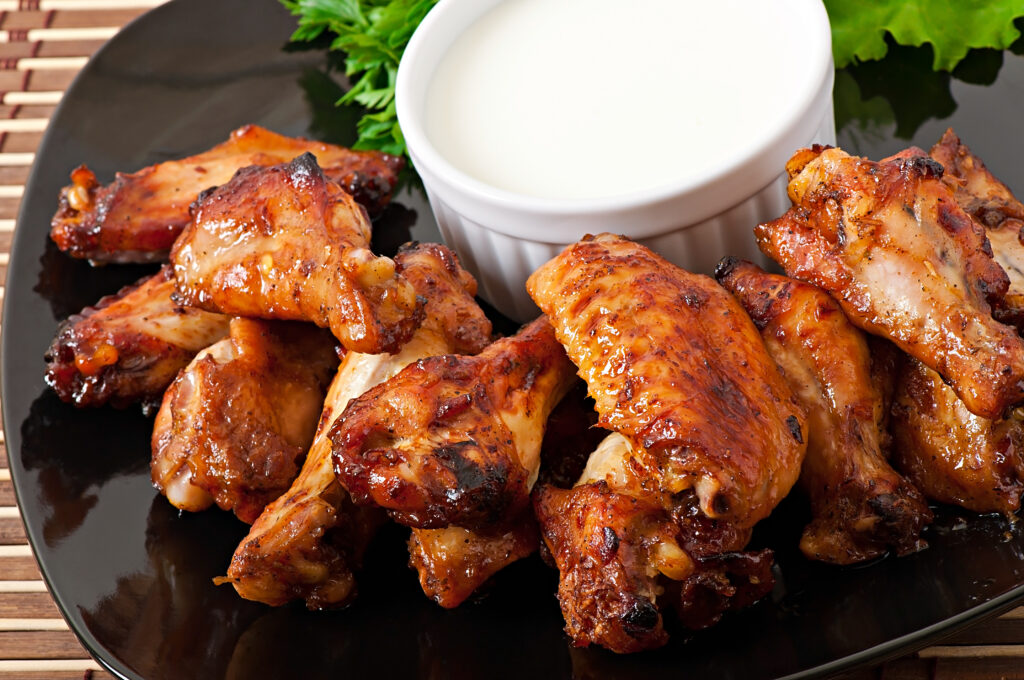Crispy chicken wings are a universal favorite, offering the perfect balance of crunch and juicy meat. The choice of coating—flour or cornstarch—can significantly affect the texture and flavor of the final dish. So, is it better to fry wings in flour or cornstarch? Both options have their strengths, but understanding their differences can help you achieve your ideal crispy wing.

This guide dives deep into the characteristics of flour and cornstarch, compares their results, and explores how to use them effectively for the best wings ever.
Why Coatings Matter for Fried Wings
A proper coating serves multiple purposes when frying wings:
- Creates a Protective Barrier: Coatings protect the chicken from direct heat, preventing it from drying out.
- Enhances Texture: Flour and cornstarch both add crispiness, but their textures differ significantly.
- Locks in Seasonings: The coating absorbs spices and seasonings, ensuring the flavors penetrate the wings.
For more on the role of coatings, check out Kwokspots’ guide on crispy chicken wings, which explains how cornstarch creates a lighter crust.
Characteristics of Flour as a Coating
Flour has long been the go-to coating for fried chicken, delivering a classic and hearty crunch.
What Flour Does for Fried Wings
- Thick Crust: Flour creates a robust, slightly chewy crust that feels substantial.
- Flavor Absorption: Its structure holds onto seasonings, making it ideal for spicy or bold flavors.
Types of Flour for Frying
- All-Purpose Flour: The most versatile and widely used choice.
- Rice Flour: A lighter, gluten-free alternative that still produces a satisfying crunch.
- Gluten-Free Flour Blends: Perfect for those with dietary restrictions.
Pros and Cons of Flour
- Pros:
- Easily accessible.
- Retains seasoning exceptionally well.
- Cons:
- Can result in a denser crust that may feel heavy.
- Takes longer to crisp compared to cornstarch.
For detailed tips on frying with flour, explore Made With Lau’s recipe for fried chicken wings.
Characteristics of Cornstarch as a Coating
Cornstarch, a staple in many Asian recipes, is prized for its ability to create a light and ultra-crispy crust. Its unique properties make it a favorite for achieving a delicate, airy texture.
What Cornstarch Does for Fried Wings
- Lighter Crust: Cornstarch crisps up faster and more evenly than flour.
- Moisture Control: It absorbs surface moisture, ensuring the skin remains dry and crispy.
Why It’s Popular
Cornstarch is a key ingredient in Asian-style crispy wings, where its ability to create a thin, crackly crust enhances the eating experience.
Pros and Cons of Cornstarch
- Pros:
- Produces a crispier, lighter crust.
- Great for high-heat cooking methods like deep frying and air frying.
- Cons:
- Does not retain seasoning as well as flour.
- Can be too delicate for heavy sauces.
To understand the role of cornstarch in creating crispy textures, visit Eclectic Recipes’ guide to fried chicken wings.
Comparing Flour and Cornstarch for Fried Wings
When deciding between flour and cornstarch, consider the following factors:
1. Texture
- Flour: Produces a hearty, dense crust that feels substantial and traditional.
- Cornstarch: Results in a thin, crisp, and delicate crust, perfect for lighter meals or appetizers.
2. Flavor Retention
- Flour excels at absorbing and retaining spices, making it ideal for recipes with bold seasoning.
- Cornstarch is less effective at holding onto seasonings, so additional seasoning after frying may be required.
3. Cooking Time
- Flour-coated wings take slightly longer to crisp up due to the thickness of the coating.
- Cornstarch crisps up faster, making it ideal for quick frying methods.
The Best of Both Worlds: Combining Flour and Cornstarch
For a balanced texture that combines the structure of flour with the lightness of cornstarch, use a combination of both.
Why Use a Blend?
- Flour: Adds heft and helps retain seasoning.
- Cornstarch: Creates a crisp, airy texture that prevents the crust from feeling heavy.
Perfect Ratio
Start with a 50:50 blend of flour and cornstarch. Adjust the ratio depending on whether you want a heavier or lighter crust.
Cooking Techniques for Flour and Cornstarch
The coating is only part of the equation. The cooking method plays a crucial role in achieving the perfect texture.
Flour-Coated Wings
- Best Cooking Method: Deep frying at 350–375°F for even browning.
- Tips:
- Avoid overcrowding the fryer to maintain consistent oil temperature.
- Let the coated wings rest for 5–10 minutes before frying to improve adhesion.
Cornstarch-Coated Wings
- Best Cooking Method: Air frying or shallow frying for a quick, crispy finish.
- Tips:
- Shake off excess cornstarch to avoid clumping.
- Use medium-high heat for an even, golden crust.
Advanced Tips for Perfectly Fried Wings
To elevate your wings, try these advanced techniques:
1. Double Frying
- Fry the wings once at a lower temperature (around 325°F) to cook the meat.
- Fry them again at a higher temperature (375°F) to crisp up the skin.
2. Seasoning After Frying
If you’re using cornstarch, add a final sprinkle of seasoning or toss the wings in a dry rub after frying for added flavor.
3. Marinating Before Frying
Marinate the wings for extra flavor, but ensure they’re dried thoroughly before applying the coating to maintain crispiness. For marinade ideas, check out should I marinate wings before deep frying.
FAQs About Flour vs. Cornstarch for Fried Wings
Which is better for crispy wings, flour or cornstarch?
Cornstarch creates a lighter, crispier crust, while flour produces a denser, more traditional crust. Your choice depends on personal preference.
Can I use flour and cornstarch together?
Yes! Combining the two provides the best of both worlds—crispiness from cornstarch and flavor retention from flour.
What’s the best cooking method for cornstarch-coated wings?
Air frying or shallow frying works best, as these methods allow the cornstarch to crisp evenly.
Does cornstarch or flour absorb more seasoning?
Flour absorbs more seasoning, making it ideal for heavily spiced recipes.
Are there gluten-free alternatives to flour for frying wings?
Yes, rice flour or gluten-free flour blends can replicate the texture of traditional flour without gluten.
Conclusion
So, is it better to fry wings in flour or cornstarch? The answer depends on your goals. Flour offers a hearty, flavorful crust, while cornstarch delivers a lighter, crispier result. For the ultimate balance, combine the two and experiment with ratios to suit your taste.
Try these methods in your kitchen and see what works best for you. For more inspiration, explore crispy chicken wings without frying or enjoy a flavorful twist with fried chicken wings with Italian salad dressing. With the right coating and technique, perfectly crispy wings are always within reach!
